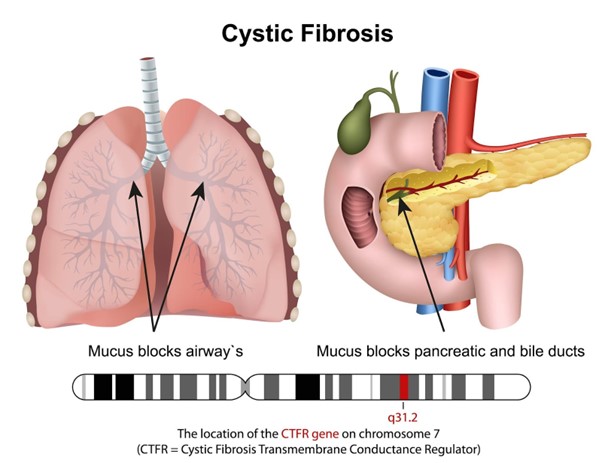A nurse is caring for an adolescent client who has cystic fibrosis. Which of the following actions should the nurse instruct the client to take prior to initiating postural drainage?
Complete oral hygiene.
Use an ibuterol inhaler.
Take pancrelipase.
Eat a meal.
The Correct Answer is B
The correct answer is B.
Choice A reason: Completing oral hygiene is important for overall health, especially for individuals with cystic fibrosis, as they are at a higher risk for dental problems due to thick mucus that can harbor bacteria. However, oral hygiene does not have a direct impact on the effectiveness of postural drainage. Postural drainage is a technique used to clear mucus from the lungs, and while maintaining oral hygiene is beneficial, it is not a prerequisite for this procedure.
Choice B reason: Using a bronchodilator, such as an ibuterol inhaler, is recommended before postural drainage because it helps to open the airways, making the procedure more effective. Bronchodilators work by relaxing the muscles around the airways, which can become constricted in conditions like cystic fibrosis. This relaxation allows for easier clearance of mucus during postural drainage.
Choice C reason: Pancrelipase is an enzyme supplement used to aid digestion in patients with cystic fibrosis, who often have pancreatic insufficiency. While taking pancrelipase is crucial for nutrient absorption, it is not specifically related to the respiratory treatment of postural drainage. Therefore, it is not necessary to take pancrelipase immediately before this procedure.
Choice D reason: Eating a meal before postural drainage is not recommended. The procedure involves placing the body in positions that facilitate the drainage of mucus from the lungs due to gravity. Having a full stomach can cause discomfort, increase the risk of vomiting, and may hinder the effectiveness of the drainage. It is best to perform postural drainage when the stomach is empty, either before meals or at least 1.5 hours after eating.

Nursing Test Bank
Naxlex Comprehensive Predictor Exams
Related Questions
Correct Answer is C
Explanation
The correct answer is choice C. Administering potassium via IV bolus is an example of malpractice in nursing.
This is because potassium is a medication that can cause cardiac arrest if given too quickly or in high doses. A nurse who administers potassium via IV bolus is not providing the standard of care that a similarly trained nurse would have offered under the same circumstances.
This could result in harm or death to the patient.
Choice A is wrong because placing a yellow bracelet on a client who is at risk for falls is not malpractice, but rather a safety measure.
A yellow bracelet indicates that the client needs assistance with mobility and should not be left alone. This is a common practice in many health care facilities to prevent falls and injuries.
Choice B is wrong because leaving a nasogastric tube clamped after administering oral medication is not malpractice, but rather a mistake.
A nasogastric tube is a tube that goes through the nose and into the stomach to deliver nutrition or medication.
It should be unclamped after giving oral medication to allow the medication to enter the stomach and prevent reflux or aspiration. However, this error does not rise to the level of malpractice unless it causes harm to the patient, such as vomiting, choking, or infection.
Choice D is wrong because documenting communication with a provider in the progress notes of the client’s medical record is not malpractice, but rather a good practice. A nurse
Correct Answer is B
Explanation
Obtain the specimen from the retention port. This is because the retention port is a sterile site that can be accessed by a syringe to aspirate urine without contaminating the specimen or the closed drainage system. The retention port should be cleaned with an alcohol swab before inserting the syringe. The specimen should be transferred to a sterile container and labeled appropriately.
Choice A is wrong because unclamping the collection port below the bag would allow urine to flow out of the bag, which is not sterile and may contain bacteria or sediment. Choice C is wrong because disconnecting the catheter from the collection tubing would break the closed drainage system and increase the risk of infection. Choice D is wrong because using the balloon port to obtain the sterile specimen would deflate the balloon that holds the catheter in place and cause trauma to the bladder wall.
Normal ranges for urine characteristics vary depending on the type of analysis, but some general parameters are:
- Color: pale yellow to amber
- Clarity: clear or slightly cloudy
- Odor: faint aromatic
- pH: 4.5 to 8.0
- Specific gravity: 1.005 to 1.030
- Protein: <150 mg/24 hr
- Glucose: negative
- Ketones: negative
- Blood: negative
- Nitrites: negative
- Leukocyte esterase: negative
- Bacteria: <10,000 CFU/mL
Whether you are a student looking to ace your exams or a practicing nurse seeking to enhance your expertise , our nursing education contents will empower you with the confidence and competence to make a difference in the lives of patients and become a respected leader in the healthcare field.
Visit Naxlex, invest in your future and unlock endless possibilities with our unparalleled nursing education contents today
Report Wrong Answer on the Current Question
Do you disagree with the answer? If yes, what is your expected answer? Explain.
Kindly be descriptive with the issue you are facing.
